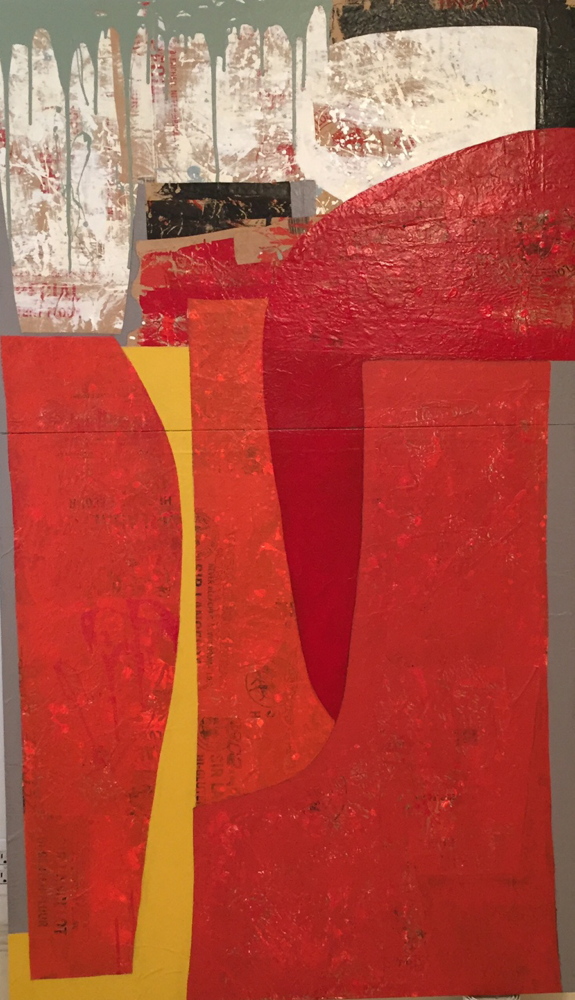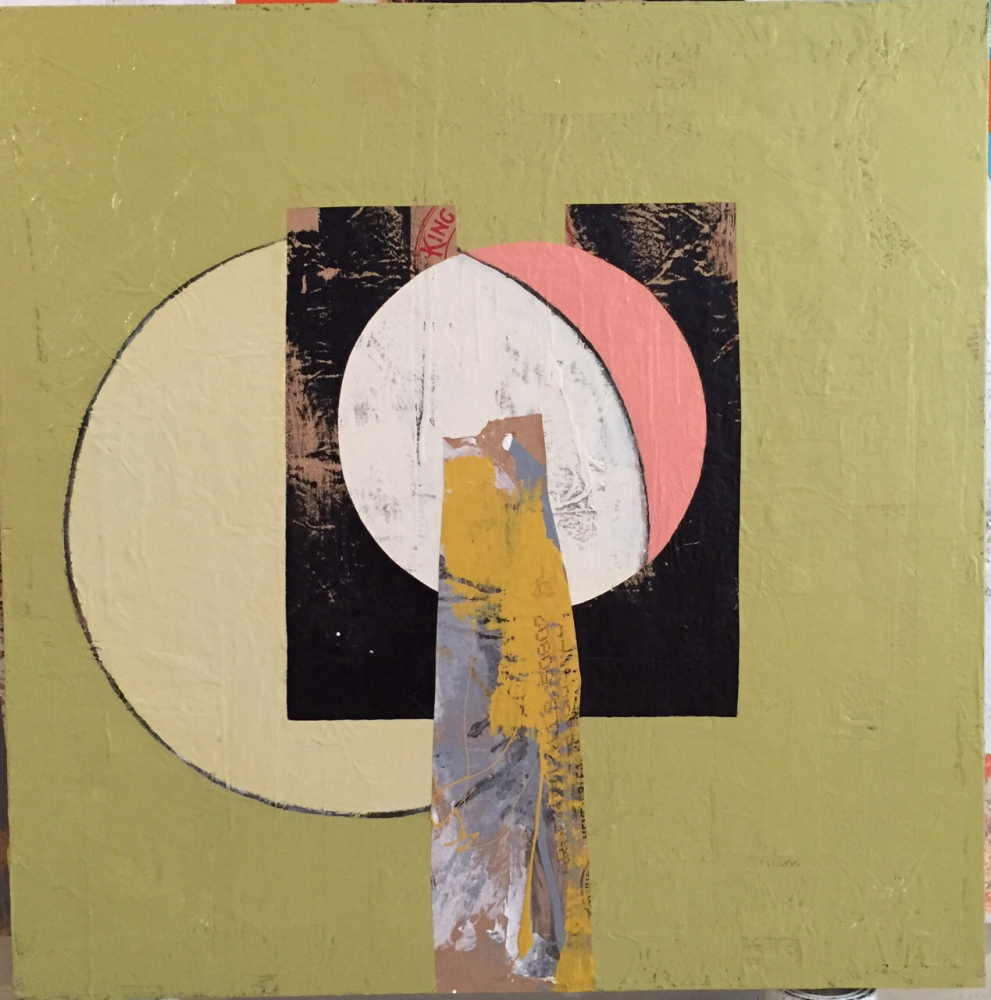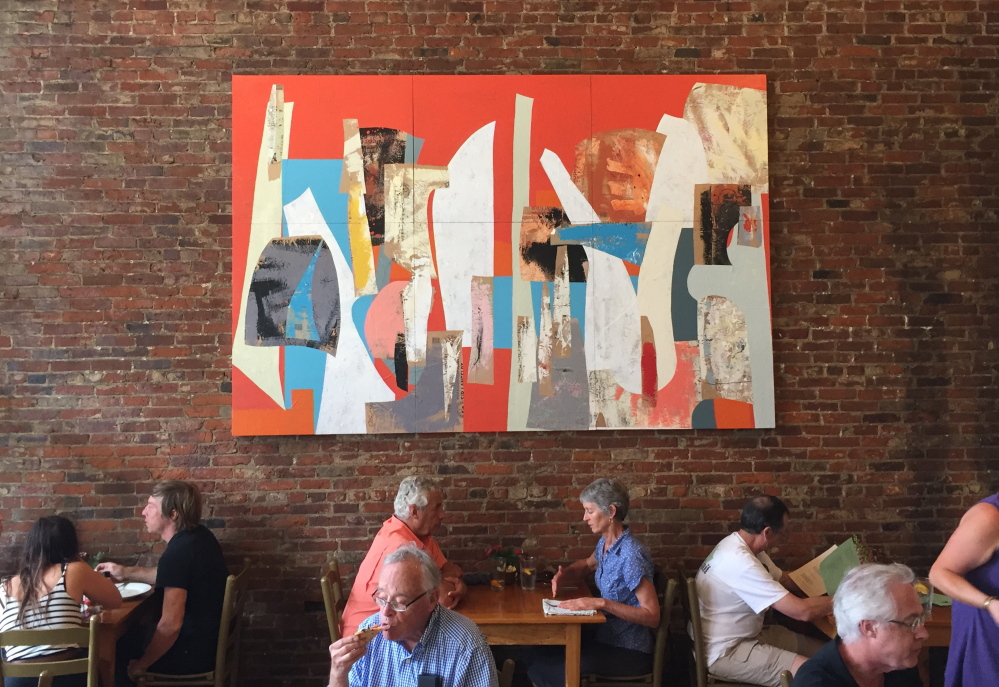Scale matters. With visual art, changes in size can even change the nature of a thing. This came into particular focus when I visited Daniel Anselmi’s show “Pageantry” at the Perimeter Gallery in Belfast.
Perimeter Gallery is basically the walls of Chase’s Daily, a popular restaurant and produce market. However, the shape and active energy of the space make it one of the better venues in Maine for large two-dimensional works.
I particularly enjoyed Anselmi’s previous show at Carver Hill Gallery, so I was interested to see what he would do with the challenge of expanding his scale for Perimeter’s soaring walls. I was impressed with how Anselmi handled the challenge, but I also came away with the idea that, as collage grows beyond the scale of paper, it necessarily comes to be seen as painting. The irony is that, because of “Pageantry,” I now see Anselmi’s smaller works as bound to the logic and legibility of collage when I had always preferred to think of them as paintings.
Of course, paper can be used as a base for painting. No one makes more powerful paintings in Maine than Tom Hall, for example, and newspapers are a key component of his dark and heavily varnished landscapes.
But “Pageantry” made me rethink the relationship between paint and paper. I have always been intrigued by the three-legged stance of Matisse’s large paper cut-outs: They were made of paper painted to match the colors for printing. The paper was cut and then pinned into place rather than glued (at least, not at first). Collage means “glued” in French and, as an element of painting, the practice came out of the cubism of Braque and Picasso – Matisse’s nemesis and rival. They raised the question, are Matisse’s cut-outs more about printmaking, collage or painting?
My answer had been “yes!” But in Belfast, it changed to “door #3.”
Anselmi has long used chart paper to make beautiful, abstract works of art. He paints some of the paper, but his strongest works generally rely on subtle value shifts within a monochromatic palette. A given work may appear as off-white or blue, and throughout the surface, forms will undulate, curve quietly and shift rhythmically against straight-edged lines that add an underlying zing of precision.
While the look of Anselmi’s work is based in cubism (the monochromatic evenness of early cubism combined with the formal gymnastics of late cubism – the birthplace of collage), its logic is more properly associated with the postwar American abstraction of de Kooning and his legacy. Specifically, Anselmi’s elegant abstractions look to de Kooning’s seminal “Attic” series and his great “Excavation” of 1950, a white painting carved up into a matrix of forms by jumpy black lines and a few jangled bits of color. (While Pollock’s looping drips defy being repurposed into descriptive shapes, de Kooning’s “Attic” shapes overlap each other until they dissolve into an effervescent field of indistinguishable forms.)
Anselmi’s forms are elegant, but he insistently denies their ability to distill into recognizable figures. Instead, they dance among system aspects like composition, circuitry and rhythm, and they teasingly flicker between positive and negative space. It’s like Anselmi has to keep stirring to keep his sauce from breaking.
That, at least, is what happens with Anselmi’s smaller works. The only works of this scale in “Pageantry,” however, are four framed and very handsome works grouped on a far wall. And they are collages. They feature paint and painting, but their textural foundation remains with the scale of the printed page, the feel of the paper and the sharpness of its edges that rise over each other in slivered layers.
Anselmi’s new large works, however, are paintings. While they clearly reveal the painted and cut paper used as supports for their forms, the vastness of color, the wrinkled textures (that we usually associate with house paint) and the bold shifts between glossy and matte textures (think Tom Hall) require us to step back to take in their full and bold structures. And despite the quickness of their painted textures, they are tableaux-large, satisfying paintings.
One very large piece featuring white, blue and neutral vertical forms parading over a vermilion ground hangs above the restaurant space. “The Banquet” has the boldness and formal breadth of a major painting (though more Motherwell than de Kooning), so it commands the space easily from afar, whereas most collage calls for the intimacy of textural detail.
A trio of large vertical compositions in the back gallery space rises together, but the difference between the works reveals a new, more painterly, range for Anselmi. His saturated palette now breathes with more space between the larger – but fewer – elements, and this allows colored forms to play new, more active and more individual roles within the images. Under an upper gray passage, a curving red form (think Matisse) reaches down in from the right of “King Arthur.” From close up, the red form dominates but, from any distance, a yellow negative space form in the lower left pops from the orange ground even more powerfully.
In another large square work, organically arched black trapezoids stretch to control a vast space textured by white paint and energized by bending puce gray forms.
Taking his own cue for a painterly idiom, “Round Table,” a smaller square work, uses fewer elements to play a geometrical game in which a circle is eclipsed by a square which in turn uses another circle to create a sphere by using the curve of the outer circle for the appearance of depth. Anselmi, however, reels in the whole act by strapping it in from the bottom with a thickly painted papery slab as the top layer.
It is this kind of witty play that makes Anselmi’s new work particularly enjoyable. While playfulness underlies all of his work, most of what I have seen is more marked by attractiveness than wit. While I don’t think the lighter-touch large works are better than Anselmi’s chart-sized works, they reveal a painterly aspect that is new for him. If he can now move fluidly between collage and painterly modes, then Anselmi is a better artist than ever.
Freelance writer Daniel Kany is an art historian who lives in Cumberland. He can be contacted at:
dankany@gmail.com
Send questions/comments to the editors.





Success. Please wait for the page to reload. If the page does not reload within 5 seconds, please refresh the page.
Enter your email and password to access comments.
Hi, to comment on stories you must . This profile is in addition to your subscription and website login.
Already have a commenting profile? .
Invalid username/password.
Please check your email to confirm and complete your registration.
Only subscribers are eligible to post comments. Please subscribe or login first for digital access. Here’s why.
Use the form below to reset your password. When you've submitted your account email, we will send an email with a reset code.